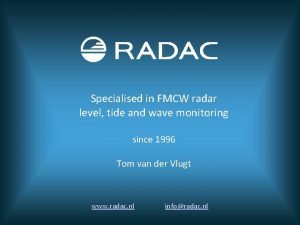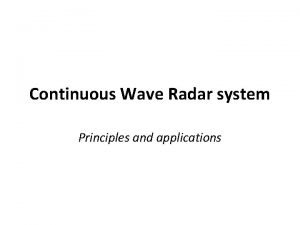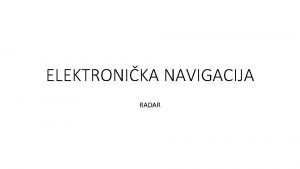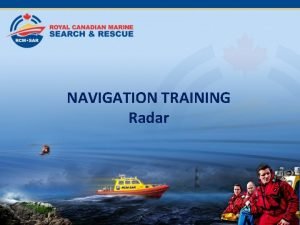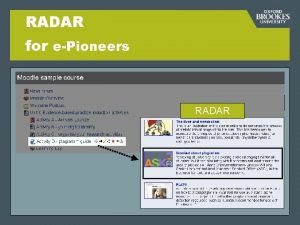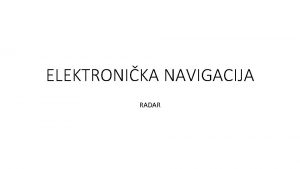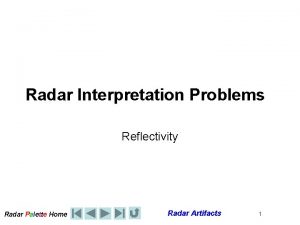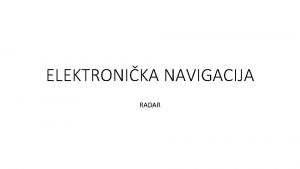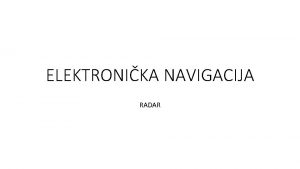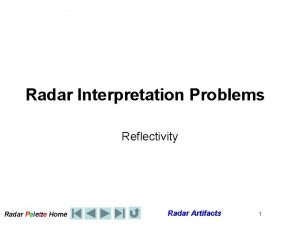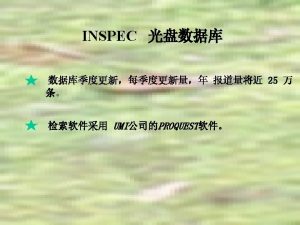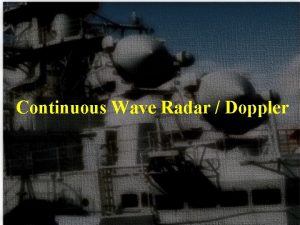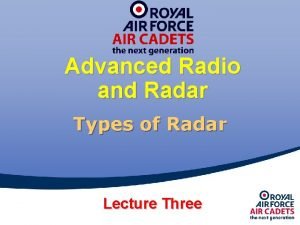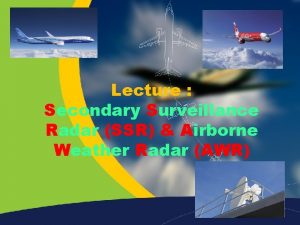Lecture Continuous Wave Radar Continuous Wave Radar CW


















- Slides: 18

Lecture Continuous Wave Radar

Continuous Wave Radar CW radar sets transmit a high-frequency signal continuously. The echo signal is received and processed permanently too. The transmitted signal of these equipments is constant in amplitude and frequency. These equipments are specialized in speed measuring. E. g. these equipments are used as speed gauges of the police.

One has to resolve two problems with this principle: • prevent a direct connection of the transmitted energy into the receiver (feedback connection), • assign the received echoes to a time system to be able to do run time measurements.

A direct connection of the transmitted energy into the receiver can be prevented by: • spatial separation of the transmitting antenna and the receiving antenna, e. g. the aim is illuminated by a strong transmitter and the receiver is located in the missile flying direction towards the aim; • frequency dependent separation by the Doppler-frequency during the measurement of speeds.

A run time measurement isn't necessary for speed gauges, the actual range of the delinquent car doesn't have a consequence. If you need range information, then the time measurement can be realized by a frequency modulation or phase keying of the transmitted power.

A CW-radar transmitting a unmodulated power can measure the speed only by using the Doppler-effect. It cannot measure a range and it cannot differ between two reflecting objects.

Continuous Wave Radar

CW radar sets transmit a high-frequency signal continuously. The echo signal is received and processed permanently. One has to resolve two problems with this principle: - prevent a direct connection of the transmitted energy into the receiver (feedback connection), - assign the received echoes to a time system to be able to do run time measurements.

A direct commutation of the transmitted energy with the receiver can be prevented by: - spatial separation of the transmitting antenna and the receiving antenna, - frequency dependent separation by the Doppler-frequency during the measurement of speeds.

A run time measurement isn't necessary for speed gauges, the actual range of the delinquent car doesn't have a consequence. If you need range information, then the time measurement can be realized by a frequency modulation or phase keying of the transmitted power. A CW-radar transmitting a unmodulated power can measure the speed only by using the Doppler- effect. It cannot measure a range and it cannot differ between two reflecting objects.

Block Diagram of an CW-Radar Simple CW Doppler- Radar sets have the following design:

The generator generates very stable RFFrequency fs. A second generator generates the IF-frequency f. ZF. A mixer stage with a following narrowband filter generates the stable local-oscillatorfrequency fs+f. ZF as sum of the transmitter’s frequency and a generated IF-frequency.

As a part of the superheterodyne receiver the next mixer stage converts the backscattered RF- signals fs+f. D to the IF- frequency. The IF- amplifier makes the receiver very sensitive for the weak echo signals. The output of the last mixer stage is the Doppler-frequency f. D only. The frequency counter counts the Doppler-frequency and by means of this counted value calculates the speed. In order to obtain a precise result, this calculation procedure must be calibrated in accordance by an exactly specified radiation angle to the carriageway.

A mixer stage with a following narrowband filter generates the stable local-oscillator-frequency as sum of the transmitter's frequency and a generated IF-frequency.

Frequency-Modulated Continuous. Wave Radar Ranging with an FMCW system tx-signal Echo

Echo CW radars have the disadvantage that they cannot measure distance, because there are no pulses to time. In order to correct for this problem, frequency shifting methods can be used. In the frequency shifting method, a signal that constantly changes in frequency around a fixed reference is used to detect stationary objects.

When a reflection is received the frequencies can be examined, and by knowing when in the past that particular frequency was sent out, you can do a range calculation similar to using a pulse. It is generally not easy to make a broadcaster that can send out random frequencies cleanly, so instead these Frequency. Modulated Continuous Wave radars (FMCW), use a smoothly varying “ramp” of frequencies up and down.

 Pulse frequency
Pulse frequency Delay line canceller in radar
Delay line canceller in radar 01:640:244 lecture notes - lecture 15: plat, idah, farad
01:640:244 lecture notes - lecture 15: plat, idah, farad Fmcw radar
Fmcw radar Future continuous to past continuous
Future continuous to past continuous Past simple future
Past simple future The nature of waves chapter 10 section 1
The nature of waves chapter 10 section 1 A ____ is a repeating disturbance or movement that
A ____ is a repeating disturbance or movement that Short wave vs long wave radiation
Short wave vs long wave radiation Velocity frequency wavelength triangle
Velocity frequency wavelength triangle Full wave rectifier
Full wave rectifier Symmetrical waveform
Symmetrical waveform Difference between full wave and half wave rectifier
Difference between full wave and half wave rectifier Earthquake p wave and swave travel time
Earthquake p wave and swave travel time Venn diagram of mechanical and electromagnetic waves
Venn diagram of mechanical and electromagnetic waves Longitudinal vs transverse waves
Longitudinal vs transverse waves Rectified sine wave fourier series
Rectified sine wave fourier series Light is electromagnetic radiation true or false
Light is electromagnetic radiation true or false Similarities of mechanical and electromagnetic waves
Similarities of mechanical and electromagnetic waves



